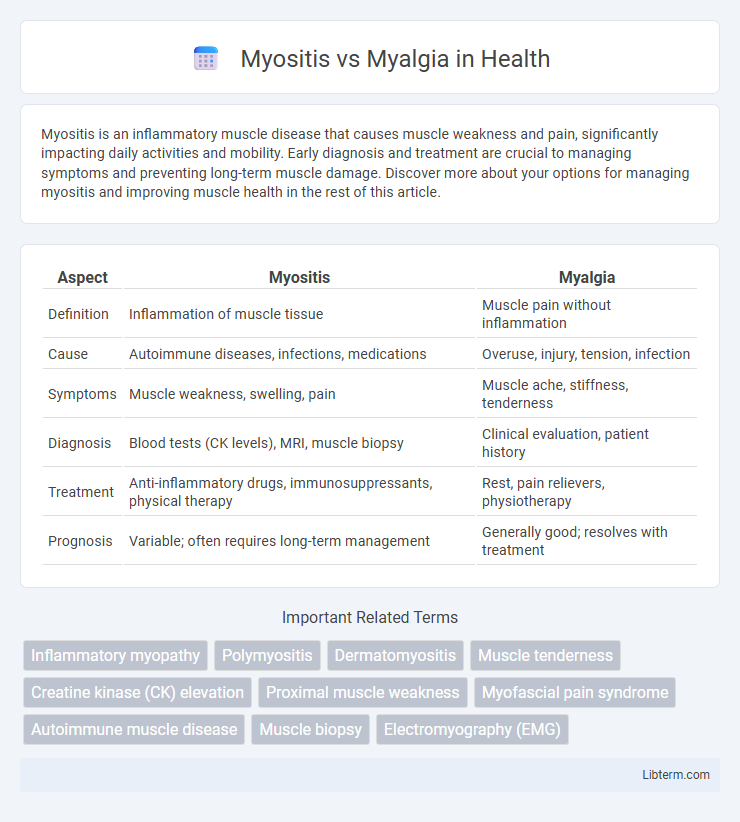Myositis is an inflammatory muscle disease that causes muscle weakness and pain, significantly impacting daily activities and mobility. Early diagnosis and treatment are crucial to managing symptoms and preventing long-term muscle damage. Discover more about your options for managing myositis and improving muscle health in the rest of this article.
Table of Comparison
| Aspect | Myositis | Myalgia |
|---|---|---|
| Definition | Inflammation of muscle tissue | Muscle pain without inflammation |
| Cause | Autoimmune diseases, infections, medications | Overuse, injury, tension, infection |
| Symptoms | Muscle weakness, swelling, pain | Muscle ache, stiffness, tenderness |
| Diagnosis | Blood tests (CK levels), MRI, muscle biopsy | Clinical evaluation, patient history |
| Treatment | Anti-inflammatory drugs, immunosuppressants, physical therapy | Rest, pain relievers, physiotherapy |
| Prognosis | Variable; often requires long-term management | Generally good; resolves with treatment |
Understanding Myositis and Myalgia
Myositis is an inflammatory muscle disease characterized by muscle weakness, swelling, and elevated muscle enzymes, often requiring medical evaluation and specific treatment protocols. Myalgia refers to generalized muscle pain or tenderness without inflammation, commonly caused by muscle strain, overuse, or viral infections. Differentiating myositis from myalgia relies on clinical symptoms, laboratory tests like creatine kinase levels, and sometimes muscle biopsy to confirm inflammation.
Key Differences Between Myositis and Myalgia
Myositis is characterized by inflammation of the muscles leading to weakness, swelling, and potential muscle damage, often diagnosed through elevated muscle enzymes and biopsy. Myalgia refers to muscle pain without inflammation, commonly associated with overuse, injury, or viral infections, and lacks significant muscle weakness or elevated muscle enzyme levels. The key difference lies in myositis involving muscle inflammation and tissue damage, while myalgia primarily entails muscle pain without inflammatory pathology.
Causes of Myositis
Myositis primarily results from autoimmune diseases, infections, certain medications, and environmental factors that trigger inflammation of muscle tissues. Viral infections such as influenza, HIV, and hepatitis, as well as bacterial infections like staphylococcus, are common infectious causes of myositis. In contrast, myalgia generally refers to muscle pain caused by overuse, injury, or systemic conditions without underlying inflammation.
Causes of Myalgia
Myalgia, characterized by muscle pain or soreness, commonly results from muscle overuse, tension, or injury, often due to intense physical activity, stress, or poor ergonomics. Viral infections like influenza or conditions such as fibromyalgia and hypothyroidism can also cause myalgia by triggering inflammation or disrupting muscle metabolism. Unlike myositis, which involves inflammatory muscle disease causing weakness and muscle inflammation, myalgia primarily reflects pain without significant inflammation.
Symptoms: Myositis vs Myalgia
Myositis presents with muscle weakness, swelling, and tenderness, often accompanied by inflammation visible in blood tests and imaging, whereas myalgia primarily involves muscle pain and stiffness without significant weakness or inflammation. Patients with myositis may experience difficulty performing daily activities due to progressive muscle weakness, while myalgia symptoms are generally milder, related to muscle strain or exertion. Elevated creatine kinase levels and muscle biopsy can help distinguish myositis from myalgia by confirming muscle inflammation and damage.
Diagnosis Methods for Myositis and Myalgia
Diagnosis methods for myositis primarily involve blood tests measuring elevated muscle enzymes such as creatine kinase (CK), electromyography (EMG) to detect muscle abnormalities, and muscle biopsy to confirm inflammation. Myalgia diagnosis relies more on clinical evaluation of pain patterns, physical examination, and ruling out underlying causes through imaging like MRI or ultrasound, with less emphasis on invasive procedures. Both conditions may also require autoimmune panels to identify associated disorders affecting muscle tissue.
Treatment Options for Myositis
Myositis treatment primarily involves immunosuppressive medications such as corticosteroids and disease-modifying antirheumatic drugs (DMARDs) to reduce muscle inflammation. Physical therapy is essential to maintain muscle strength and prevent contractures. In severe cases, intravenous immunoglobulin (IVIG) and biologic agents like rituximab may be used to manage refractory symptoms.
Treatment Strategies for Myalgia
Treatment strategies for myalgia typically involve addressing the underlying cause, such as muscle strain, overuse, or systemic conditions. Management often includes rest, physical therapy, nonsteroidal anti-inflammatory drugs (NSAIDs), and muscle relaxants to alleviate pain and inflammation. In contrast, myositis requires immunosuppressive therapies and corticosteroids due to its inflammatory muscle disease nature.
Prevention Tips for Muscle Disorders
Effective prevention of myositis and myalgia involves regular physical activity combined with proper warm-up and cool-down routines to reduce muscle strain. Maintaining balanced nutrition rich in anti-inflammatory foods supports muscle health and reduces risk of inflammatory muscle disorders. Avoiding repetitive motions, managing stress, and seeking early medical advice for persistent muscle pain contribute to lowering the incidence of both myositis and myalgia.
When to Seek Medical Attention
Persistent muscle weakness or swelling, often seen in myositis, warrants prompt medical evaluation to prevent complications and initiate treatment. Myalgia typically presents as muscle pain but requires urgent care if accompanied by symptoms such as fever, dark urine, or severe muscle tenderness, which may indicate rhabdomyolysis or infection. Early diagnosis through blood tests, electromyography, or muscle biopsy is critical for differentiating myositis from myalgia and guiding appropriate intervention.
Myositis Infographic

 libterm.com
libterm.com